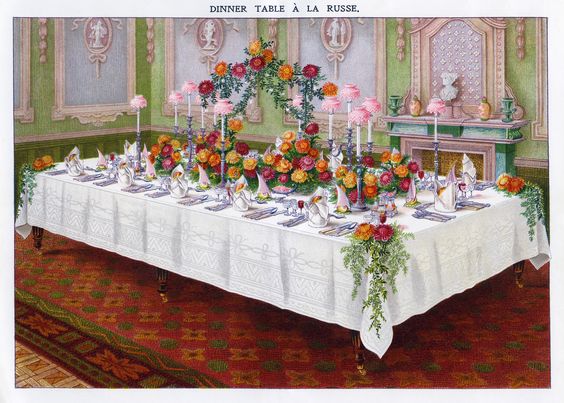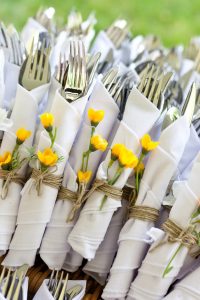Mrs Beeton’s Dinner table Setting
During the Victorian era, Sir William Schwenck Gilbert and his wife, Lucy, hosted some amazing dinner parties at Grim’s Dyke. They were the talking point of local society, not least because the family lemurs often made an appearance!
Victorian dinner parties were all about status, refinement and attention to detail – and Lady Gilbert excelled in these areas. If you want to host your own Victorian-themed dinner party, here are the important points to remember.
Invitations
If you want to keep with tradition, you’ll want to send out invitations out – between two days to two weeks prior to the event – and guests must reply. It was also good form to specify the number of guests attending, so guests could dress appropriately and arrival time would be 8 – 8.15, for dinner to start at 9pm.
Seating arrangements and place settings
All place settings need to be on a strict protocol – male, then female, alternating round the table. Each setting would have its own salt and butter dishes, along with a finger bowl and a small menu, to remind guests of the delights to come.
The table would be laid out with 3-4 glasses and up to 8 knives and forks, depending on the menu for the evening – as even ice cream was eaten with a fork!
Table decorations
Flowers and herbs were frequently used to create a massive centrepiece for the dining table. The food was then placed on the sideboard, for easy (and less crowded!) service.
You can also add Victorian authenticity, by using sprigs of herbs and flowers to decorate each place setting and folded in each napkin, and you can float individual flowers in the finger bowls.
How many courses?
You can host a simple, yet elegant evening, with three courses – but it wasn’t uncommon for the Victorian dinner party to consist of 9 courses!
The different courses
So what edible delights would your guests be expecting? The more complex evenings would consist of the following courses (in order):
- Soup (one or two courses)
- Appetisers (such as sardines and shrimp, celery and anchovies) sometimes served with side dishes (such as pickles, stewed hare and minced meats)
- Sorbet (to refresh the palette, prior to the main meal)
- Roast meat, served with a variety of vegetables and green salad
- Sweet pastries, pies cakes, candies, chocolates and crackers
- Cheese, fruits and nuts
- Tea and coffee
The grand finale
The dessert course was considered as the grand finale for any dinner party. A large cake would be splendidly decorated with herbs and edible flowers, such as Lemon Verbena, Lemon Balm, Mint and Peppermint. You can then place smaller treats and goodies around the cake.
Drinks during the meal
It was usual to offer sherry during the appetisers, wine and champagne with the main courses, before returning to the sherry for the dessert courses.
After dinner drinks
Whether you’re hosting an afternoon or evening meal, it was common practice to serve fruit and herbal teas after you’ve eaten. This could be to aid digestion after eating your way through all those courses, but it’s also a good way to socialise after the meal. Elder flower and berry drinks were considered very appealing at this stage of the dinner party.
Entertainment
Music and entertainment inevitably followed any grand Victorian dinner party – and the Gilbert’s excelled in this area too. If you want to follow in their footsteps, look to have readings of Gilbert and Sullivan operettas, musical recitals or poetry readings, before rounding off the evening at 11-11.30pm.



